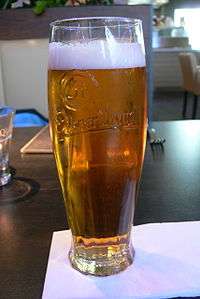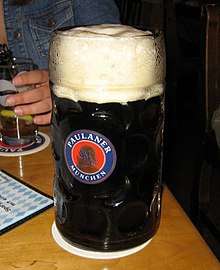Lager
Lager is a type of beer conditioned at low temperature.[1] Lagers can be pale, amber, or dark. Pale lager is the most widely consumed and commercially available style of beer. Well-known brands include Asahi, Carlton Draught, Pilsner Urquell, Molson Canadian, Miller, Stella Artois, Beck's, Brahma, Budweiser Budvar, Corona, Snow, Tsingtao, Singha, Sapporo, Kirin, Quilmes, Heineken, Kingfisher, Carlsberg, Birra Moretti and Tennents.
As well as maturation in cold storage, most lagers are also distinguished by the use of Saccharomyces pastorianus yeast, a "bottom-fermenting" yeast that also ferments at relatively cold temperatures. It is possible to use lager yeast in a warm fermentation process, such as with American steam beer; while German Altbier and Kölsch are brewed with Saccharomyces cerevisiae top-fermenting yeast at a warm temperature, but with a cold-storage finishing stage, and classified as obergäriges lagerbier (top-fermented lager beer).[2][3]
Etymology
Until the 19th century, the German word lagerbier (de) referred to all types of bottom-fermented, cool-conditioned beer in normal strengths. In Germany today, it mainly refers to beers in southern Germany,[4] "Helles" (pale) and "Dunkel" (dark). Pilsner, a more heavily hopped pale lager, is most often known as "Pilsner", "Pilsener", or "Pils". Other lagers are Bock, Märzen, and Schwarzbier. In the United Kingdom, the term commonly refers to pale lagers derived from the Pilsner style.[5]
History of lager brewing
While cold storage of beer, "lagering", in caves for example, was a common practice throughout the medieval period, bottom-fermenting yeast seems to have emerged as a hybridization in the early fifteenth century. In 2011, a team of researchers claimed to have discovered that Saccharomyces eubayanus is responsible for creating the hybrid yeast used to make lager.[6][7]
Based on the numbers of breweries, lager brewing became the main form of brewing in the Kingdom of Bohemia between 1860 and 1870, as shown in the following table:[8]
| Year | Total Breweries | Lager Breweries | Lager Percentage |
|---|---|---|---|
| 1860 | 416 | 135 | 32.5% |
| 1865 | 540 | 459 | 85.0% |
| 1870 | 849 | 831 | 97.9% |
In the 19th century, prior to the advent of refrigeration, German brewers would dig cellars for lagering and fill them with ice from nearby lakes and rivers, which would cool the beer during the summer months. To further protect the cellars from the summer heat, they would plant chestnut trees, which have spreading, dense canopies but shallow roots which would not intrude on the caverns. The practice of serving beer at these sites evolved into the modern beer garden.[9]
The rise of lager was entwined with the development of refrigeration, as refrigeration made it possible to brew lager year-round (brewing in the summer had previously been banned in many locations across Germany), and efficient refrigeration also made it possible to brew lager in more places and keep it cold until serving.[10] The first large-scale refrigerated lagering tanks were developed for Gabriel Sedelmayr's Spaten Brewery in Munich by Carl von Linde in 1870.[10]
Production process
Lager beer uses a process of cool fermentation, followed by maturation in cold storage. The German word "Lager" means storeroom or warehouse. The yeast generally used with lager brewing is Saccharomyces pastorianus. It is a close relative of the Saccharomyces cerevisiae yeast used for warm fermented ales.
While prohibited by the German Reinheitsgebot tradition, lagers in some countries often feature large proportions of adjuncts, usually rice or maize. Adjuncts entered United States brewing as a means of thinning out the body of beers, balancing the large quantities of protein introduced by six-row barley. Adjuncts are often used now in beermaking to introduce a large quantity of sugar, and thereby increase ABV, at a lower price than a formulation using an all-malt grain bill. There are however cases in which adjunct usage actually increases the cost of manufacture.[11]
Variations
The examples of lager beers produced worldwide vary greatly in flavor, color, composition and alcohol content.
Styles
Lagers range in color from extremely pale, through amber beers such as Vienna lager, to dark brown and black Dunkel and Schwarzbier. The depth of color comes from the specific grain bill used in the beers, paler lagers use unroasted barley and may even add other grains such as rice or corn to lighten the color and provide a crisp, bright finish to the flavor. Darker lagers use roasted grains and malts to produce a more roasted, even slightly burnt, flavor profile. Styles commonly classified as lagers include:
- Helles, a pale malty lager brewed in southern Germany around Munich.
- Pilsner, a pale hoppy lager originally from the city of Plzeň in the Czech Republic, which influenced the modern American lager style.
- Märzen, an amber lager, traditionally brewed in Munich for the celebration of Oktoberfest, though the beer served at modern day Oktoberfest is Festbier, a style closer to Maibock or Helles than Märzen.
- Bock, originating in Einbeck in central Germany, is of a higher alcohol content (7% abv or more) than most lagers. Sub-styles include Maibock (traditionally served in May, lighter in color and body), Doppelbock (with an even higher alcohol content), and Eisbock, a type of ice beer which has been concentrated by freezing.
- Vienna lager, which can range from medium amber to brown, originating in Vienna, Austria, but also influencing brewing in Mexico, typified by beers such as Dos Equis Ambar.
- Dunkel, a dark brown lager; the word (meaning dark) can also be appended to other styles to indicate a darker variety (e.g. "Dunkelweizen").
- Schwarzbier, a dark brown to black lager.
Pale lager

The most common lager beers in worldwide production are pale lagers. The flavor of these lighter lagers is usually mild, and the producers often recommend that the beers be served refrigerated.
Pale lager is a very pale to golden-colored lager with a well attenuated body and noble hop bitterness. The brewing process for this beer developed in the mid 19th century when Gabriel Sedlmayr took pale ale brewing techniques back to the Spaten Brewery in Germany and applied it to existing lagering brewing methods.[12]
This approach was picked up by other brewers, most notably Josef Groll who produced in Bohemia (now part of the Czech Republic) the first Pilsner beer—Pilsner Urquell. The resulting pale colored, lean and stable beers were very successful and gradually spread around the globe to become the most common form of beer consumed in the world today.[13]
Vienna lager
Vienna lager is a form of Märzen, an amber to reddish-brown to copper-colored style of lager developed by brewer Anton Dreher in Vienna in 1841. German-speaking brewers who emigrated to Mexico in the late 19th century, during the Second Mexican Empire, took the style with them. Vienna lager is medium bodied with a slight malt sweetness, while Mexican Vienna lager, was developed by Santiago Graf.[14] The malt aroma and flavor may have a toasted character.[15] Despite their name, Vienna lagers are generally uncommon in continental Europe today, but can be found frequently in North America, where it is often called pre-Prohibition style amber lager, as the style was popular in pre-1919 America. Notable examples include Brooklyn Lager, Samuel Adams Boston Lager, Great Lakes Eliot Ness, Devils Backbone Vienna Lager, Abita Amber, Yuengling Traditional Lager, Dos Equis Ámbar, and August Schell Brewing Company Firebrick. In Norway, the style has retained some of its former popularity, and is still brewed by most major breweries.
Dark lager

Lagers would likely have been mainly dark until the 1840s; pale lagers were not common until the later part of the 19th century when technological advances made them easier to produce.[16] Dark lagers range from amber to dark reddish brown, and may be termed Vienna, amber lager, Dunkel, tmavé, or Schwarzbier depending on region, color or brewing method.
Tmavé is Czech for "dark", so it is the term for a dark beer in the Czech Republic - beers which are so dark as to be black are termed černé pivo, "black beer".[17] Dunkel is German for "dark", so is the term for a dark beer in Germany. With alcohol concentrations of 4.5% to 6% by volume, Dunkel is weaker than Doppelbock, another traditional dark Bavarian beer. Dunkel was the original style of the Bavarian villages and countryside.[18] Schwarzbier, a much darker, almost black beer with a chocolate or licorice-like flavor, similar to stout, is brewed in Saxony and Thuringia.
See also
- Beer measurement, information on measuring the color, strength, and bitterness of beer
- Reinheitsgebot, an influential Bavarian and German brewing law
References
- Briggs, D.E.; Boulton, C.A.; Brookes, P. A.; and Stevens, R. Brewing, 2004, CRC. ISBN 0-8493-2547-1 p. 5.
- Jeff Alworth (2015). The Beer Bible The Essential Beer Lover's Guide. Workman Publishing. p. 234. ISBN 978-0-7611-8498-0.
- Ray Daniels (1998). Designing Great Beers The Ultimate Guide to Brewing Classic Beer Styles. Brewers Publications. ISBN 978-0-9840756-1-4.
- "Willkommen beim Deutschen Brauer-Bund: Helles Lager/Export". brauer-bund.de (in German). Retrieved September 3, 2015.
- "Pils is arguably the most successful beer style in the world". The German Beer Institute. Archived from the original on 2011-10-19.
- "500 years ago, yeast's epic journey gave rise to lager beer". Geneticarchaeology.com. Archived from the original on 2014-11-09. Retrieved 2014-04-08.
- Libkind, D; Hittinger, CT; Valério, E; et al. (2011-08-22). "Microbe domestication and the identification of the wild genetic stock of lager-brewing yeast". Proceedings of the National Academy of Sciences. 108 (35): 14539–14544. doi:10.1073/pnas.1105430108. PMC 3167505. PMID 21873232. Retrieved 2014-04-08.
- Pasteur, Louis, Studies in Fermentation, 1879. English translation reprinted 2005 Beerbooks.com ISBN 0-9662084-2-0 p10. Citing Moniteur de la Brasserie, 23 April 1871.
- Schäffer, Albert (2012-05-21). "120 Minuten sind nicht genug" [120 minutes aren't enough]. Frankfurter Allgemeine Zeitung (in German). Retrieved 2016-10-11.
- James Burke (1979). "Eat, Drink, and Be Merry". Connections. Episode 8. Event occurs at 41 (49 minutes). BBC.
- Bamforth, Charles (2003). Beer: Tap into the Art and Science of Brewing, Second Edition. Oxford University Press, Inc. ISBN 0-19-515479-7.
- "The History of Lager".
- "LAGER BEER STYLES, European All-malt Pilsener". Beermonthclub.com. Retrieved 2014-04-08.
- One Hundred Years of Brewing, Arno Press, New York, 1974
- Gregory J. Noonan, Mikel Redman and Scott Russell; Seven Barrel Brewery Brewers' Handbook; G.W. Kent, Inc; ISBN 1-887167-00-5 (paperback, 1996)
- "German Beer Guide: Dunkel". www.germanbeerguide.co.uk. Archived from the original on 2010-06-09. Retrieved 2010-05-26.
- "Pražský Most u Valšů at Beer Culture". www.beerculture.org. Retrieved 2010-09-28.
- "Dunkel". German Beer Guide. 2004-08-01. Archived from the original on 2010-06-09. Retrieved 2012-08-14.